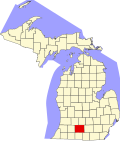This article needs additional citations for verification .(October 2024) |
Battle Creek | |||||||||||
|---|---|---|---|---|---|---|---|---|---|---|---|
 The old Michigan Central Depot in Battle Creek, Michigan | |||||||||||
| General information | |||||||||||
| Location | 44 McCamly Street N., Battle Creek, Calhoun County, Michigan 49017 | ||||||||||
| Former services | |||||||||||
| |||||||||||
Penn Central Railway Station | |||||||||||
Error: Invalid designation | |||||||||||
| Location | 44 McCamly Street N. Battle Creek, Michigan | ||||||||||
| Coordinates | 42°19′16″N85°10′53″W / 42.32111°N 85.18139°W | ||||||||||
| Built | 1888 | ||||||||||
| Architect | Rogers and MacFarlane | ||||||||||
| Architectural style | Richardsonian Romanesque | ||||||||||
| NRHP reference No. | 71000384 | ||||||||||
| Significant dates | |||||||||||
| Added to NRHP | April 16, 1971 | ||||||||||
| Designated MSHS | November 6, 1970 [1] | ||||||||||
| |||||||||||
Battle Creek station, listed in the National Register of Historic Places as the Penn Central Railway Station, is a disused train station in Battle Creek, Michigan. It opened on July 27, 1888.



